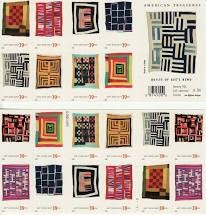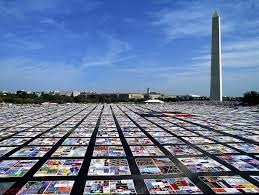Robin Mitzcavitch, Director of Religious Exploration & Education

Being a quilter, I was pleased to see the book “Stitchin’ and Pullin’’” by Patricia McKissack suggested in the curriculum we are using this year for our Religious Exploration program. The curriculum, “Growing Anti-Racist UUs- A Curriculum for Children”, was written by religious educators at the Unitarian Universalist Church of Charlottesville, VA.
In the book, which focuses on the women quilters of Gee’s Bend, Alabama, we learn how important the quilt making ritual was in this African American community. Before these incredible quilts were “discovered” and put into museums, they served as a lifeline and a storytelling tool for the emancipated former slaves. For years and years, Gee’s Bend children came of age, sitting beneath the quilting frame, listening to the stories told by their family of women, learning the craft, learning about the struggle, hopes, and dreams.
McKissack notes in the book that every quilt begins with a heart. This could be a piece of fabric from the shirt Daddy wore that first time he was ever allowed to vote. Maybe it’s a color inspiration that reminds the artist of the hearth and the fire, the trim on grandmother’s apron, the brown and muddy waters that surround Gee’s Bend on three sides.
In the evenings, quilting was the chore, and the women and children would gather. They worked, and swapped recipes, natural cures, and songs. They told the stories that their children needed to know, the ones that defined their existence and journey.
Quilts hold history. Cloth has a memory.
The storytelling continues, in other quilts found in museums, and in traveling displays and in books. The AIDS Memorial Quilt is another such creation with an overwhelming size, scope and powerful story. The Religious Exploration children will have the opportunity this coming Sunday to hear Moira Rouse speak about the AIDS Memorial Quilt, and in particular, her brother Barton’s square in that quilt. Moira’s brother passed away from AIDS in 1995. Each block in this massive quilt (48,000 blocks), tries to tell the story of a beautiful life lost to a horrifying disease.

Our Religious Exploration children are busy deciding what will be the “heart” of their own 9X9 inch quilt block. Each child will have a story to go along with the piece of art they’ll create from fabric and thread. Their block and their story will come together to live at our church, displayed on our main hall bulletin board. In the spirit of keeping the names of people and stories alive, we want to celebrate and honor what constitutes the heart of our creations. Then, as a community who lifts each other up and who shares things like stories and acceptance and guidance, we’ll put our quilt blocks together to celebrate and honor our own community.
We will, along the way, learn to appreciate the many hands that have worked to assemble love and truth, color and utility, into a quilt. The history of quilts is full of ritual. The way quilts were used are fascinating, frivolous, and often poignant. As Patricia McKissack puts it, “Our lives are like quilts. When all the bits and pieces of our remembered history are assembled, they become a link to the past and a beacon for future generations.”
May our hands stay busy with creations. May our hearts deeply hold our roots and our stories. Let us share those things which stir us with our loved ones and the world.
In Peace,
Robin
